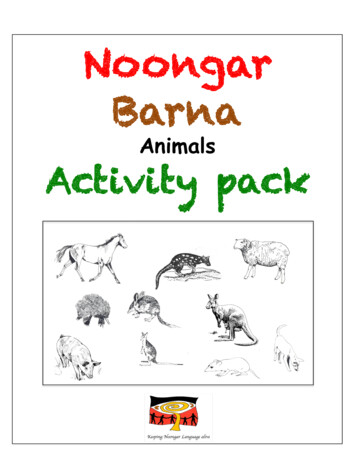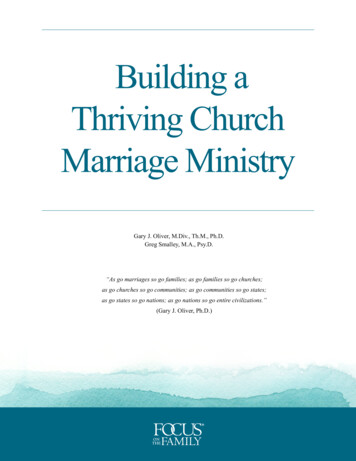
Transcription
NoongarBarnaAnimalsActivity pack
Teacher’s Background Informa4onLike many other Aboriginal and Torres Strait Islander groups, family rela4onships are veryimportant. Noongar people have large extended family connec4ons that impacts on achild’s upbringing. Noongar people use the same rela4onships terms like brother, sisteraunty and uncle when gree4ng other Noongar people who are not related which is alsocommonly used by other Aboriginal groups across Australia.It is a form of acknowledgement and respect to each other from one person to another.Noongar LanguageNoongar was spoken in a tradi4onal gramma4cal form prior to European seElement ofWA. policies of the 19th century impacted significantly on the use of tradi&onal Noongargrammar, consequently the grammar changed. It is now evolved into what is termedcontemporary Noongar.Contemporary Noongar is heavily influenced by contact with English grammar.Contemporary and tradi4onal Noongar language both are valid and used appropriately.Languages must be dynamic and evolved to survive. Research is being undertaken onboth tradi4onal and contemporary forms of Noongar language.This package uses the contemporary Noongar Language.Lesson overviewThese ac4vi4es will provide students the opportunity to engage in a step by step Noongarlanguage learning program about family.Key learning/ Purpose Iden4fy and keywords of the insects in Noongar language; To iden4fy common animal of Western Australia that are na4ve and introduced toNoongar country. To learn to read and write the Noongar keywords using the Noongar gramma4calsystem.Resources Insect keywords Work book CraR Ac4vitySupport Materials available onlinewww.noongarboodjar.com.auBush heritage rces/colouring-sheets Barna (Animals) Readers levels 1-5Page 2
Greeting circleSteps:1.2.3.4.5.First you need a Message stick (talking stick). To make one ofthese, simply take a tapping stick or a stick from the garden anddecorate any way you like.Once you have made your stick, gather your students into a circle.Explain to the students you cannot speak unless you have themessage stick. This allows everyone to have the opportunity toshare.To begin each student will pass around the message stick sayingKaya’ (ki-ya) ( meaning hello in Noongar language) and then passit on until everyone has had a turn.As you work through this program you can use other words Thiscan also be done by introducing new words from the Bird word liston page 3Page 3
Barna animals wendangortkwooraPage 4djoorditjyongkanyingarn
Maar KoorlDrawingDraw a picture of your favourite barna(animal) in a tree. Then write the name ofyour barna (animal) in the space below.Page 5
Barna (animals) word Listdjalkatbilbydjoorditjnative catdwertdogdordokpigkoomoolpossumkwendashort –nosed bandicootkwoorabrush tail marwallabyyongkakangarooNote: you can use the na.ve cat name ‘djoorditj’ todescribe your general house hold cat.Page 6
Ngiyan boodja-k nyininy?Who lives in the tree?Activity:1.Choose 4 animals from your barna word list and drawthem in the picture below.2. Write their names on the spaces below.1.2.3.4.Page 7
1. Complete the sentences by choosing family members you havefrom the barna word list on page 5.2. Then draw a picture matching your sentences in the boxes below.Example: Nidja koomool - This is a possumNidjaNidjaNidjaNidjaPage 9
1. Complete the sentences by choosing family members you havefrom the barna (animals) word list on page 5.2. Then draw a picture matching your sentences in the boxes below.Example: Nidja dwert (dog) This is a dogNidjaNidjaPage 10NidjaNidja
1. Complete the sentences by choosing family members you havefrom the barna word list on page 3.2. Then draw a picture matching your sentences in the boxes below.Example: Nidja dwert - This is a dog.Nidja .Nidja .Page 11Nidja .Nidja .
Ngiyan boodja-k nyininy?Who is living on the land?Use your barna word list to help you.1. How many kwenda can you see?2. How many yongka can you see?3. How many koomool can you see?4. How many nyingarn can you see?Page 11
Maar KoorlinyKey word: Nidja – This isInstructions: Using the your keyword ‘ Nidja’ complete thesesentences below. Choose a family member from your barna(animals) wordlist on page 5. The first one is done for you.1. Nidja koomool (possum)2. Nidja3. Nidja4. Nidja5. N6. N7.8.Page 12
Maar KoorlinyMissing letters: Fill in the missing letters of the birdskeywords. Look at your barna word list to help you.1. b r b r2. k rl3. m g4. dj d ly5. b n i b n6. b d7. n r8. w t9. ng r a10. k n a aPage 13
Matching moolPage 14
adjkooeriknePage 15
boodja(ground)Read the sentence below and drawNgort boodja-k koorliny.Horse on the ground moving.Page 16
Learn how to speak NoongarNoongar Vowel Soundsaaaeioooas in upas in caras in tenas in binas in pot or sometimes foras in book or sometimes boot.(Note: if oo is followed by a r the soundis oo r and in born) example moortfamilyLet’s try our first wordsk a y a – welcome, hello and yesm a a r – handm e n – lipsb i d i t – anty o k – girlk o o m b a - bigPage 17RECOGNISE: Traditional knowledge, language, custodians, customary laws and identity.
Noongar consonants Soundsbbwddjdwkkw-l, -l-lymnngny-p-r-rd-rt-rl-rn-t-tjwyPage ininininininininininininininininininininininbin or spinbwana (Swahili name for boss)dark or stringjudgetwitchskill (between English g and k)quietlamp or nilmillionmannilsingonion, nuisancecob, spincarolcard (like an American would say it)cart (like an American would say it)whirl (like an American would say it)torn (like an American would say it)sting (between English d and t)chairwetyell
Here are some examples of words using theNoongar consonants:bamba- stingraybwoka – kangaroo cloakdarp – knifedjen – footdwert – dogkar – spiderkwila – sharkdilbi,– fresh leaf, kwilena- dolphinbilya- rivermaaman- fathernoort – flyngany – I/myselfnyingarnnop - boymaar – handward – findmoort – familyworl –skyyoorn - bobtailkaat – headwetj – emuwaabiny – playingyongka - kangarooPage 19
Teacher notesSentencesCreate your own sentences.Noongar language word order is very different from that in English and objectS,V,O (subject verb and object) . The Noongar word order consists of S,O,V(subject object and verb.) Below is an example of the word order.1.Ngortboodj-akkoorliny.Horseground- onmoving.subject object/location-sufJix verb- ak, -k – meaning in, on, at this case on2. The next exercise will give students the opportunity to use the Noongar wordorder. Let’s start by introducing the key word boodja with added sufJix –k, boodjak (ground –in, on )Boorn tree (an object and location) –ak is the sufJix added to describe in the treeor on the tree.Generally location words, have the sufJix -ak or –k attached to describe where asubject is located : e.g. miya-k- in the house; on the house. In this case the wordmarlak is an exception due to it already has – ak in it. To make pronunciationeasier, the sufJix – ngat is then used resulting in marlak-ngat in the bush.Note: -k : if a word ends in a vowel such as a, aa, i, o, oo then the sufJix will onlybe – k as in miya-k shown above.-ak : if the word ends in a consonant then the sufJix will be –ak.Here are three examples:1. boodja-k ground-in, on2. djet-ak 1lower-in, on3. boorn-ak tree- in, onPlease refer to the Vowels and Consonants sounds on pages 15, 16 and 17.So let’s have a go in the exercise on next page.Page 20
Noongar SuffixesRules:- k: if a word ends in a vowel such as a, aa, i, o, oo then thesuffix will only be – k as in bily-ak river- in, on , at.-ak : if the word does not end with one of the vowels belowthen the suffix will be –ak as in boorn-ak tree –in.-ngat : near, inVowels: a, aa, i, o, ooLook at the last letter of each word, this will help you decidewhich suffix to use –k, -ak or -ngat.Below is a list of locations1. boorn -tree2. boodja -ground3. boya -rock4. marlak -bush5. worl -skyPage 21
SentencesCreate your own sentences.Your keyword is boorn-ak tree-inUse this keyword to make your own sentences.E.g. Koomool boorn-ak nyininy.- Possum tree-in sitting1. Koolbardi boorn-ak nyininy.2. boodja-k nyininy.3. boorn-ak nyininy.4. boodja-k nyininy.5. boodja-k nyininy.Choose words from this list:nyingarn cchidnakoomool possumkwenda short-nose bandiootyongka kangaroodordok pigPage 22
SentencesAdding locationsChoose location words below to create your own sentences.( Please look at the barna (animals) word list on page 5 to help you)E.g. Kar boodja-k nyininy. – Spider on the ground sitting.Ngarna boodja-k koorliny – Caterpillar on the flower moving.1. Koomool nyininy.2. Ngort nyininy.3. Dwert nyininy.4. Yongka koorliny.5. koorliny.Choose location words from this list:boodja-k ground-onboorn-ak tree-in,onboya-k rock-onPage 23
Puzzle ActivityPage 24Instruc4ons: Print pages 24 and 25 backto back.
Page 25
NOTES:Evalua4on of your learning PackageName: Date: Class:Rate what you thought of the Noongar lessons, circle or colour in the stars that matchwhat you think.I didn’t like themIt was okI liked them a lotIt was so much fun. Can I do more?What is something new you learnt?What did you like about the Lessons and ac4vi4es?What didn’t you like about the lessons and ac4vi4es?What would you like to do more of?What would you like to do less of?Is there anything else you would like to say about what you have learnt sofar?Page 26
NoongarBarnaAnimalsActivity packFurther InformationEducation Officer: Charmaine Councilloreducation@nbalc.org.auNoongar Boodjar Language Cultural Aboriginal CorporationPhone: (08) 9791 2224Website: www.noongarboodjar.com.au
Like many other Aboriginal and Torres Strait Islander groups, family relaonships are very important. Noongar people have large extended family connec4ons that impacts on a child’s upbringing. Noongar people use the same relaonships terms like brother, sister aunty and uncle when gree4

